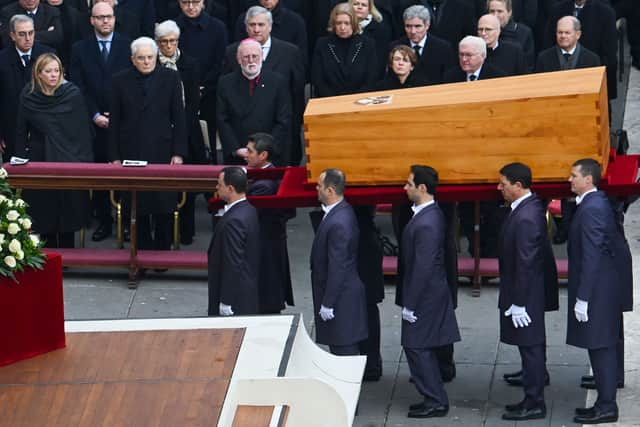Pope Benedict’s coffin: zinc and wooden coffins explained, how many are there, why are their multiple caskets?
and live on Freeview channel 276
In front of thousands of mourners in St. Peter’s Square, Pope Francis paid tribute to his predecessor Benedict XVI, presiding over a rare requiem Mass for a dead pontiff by a living one.
Bells tolled and the faithful applauded on Thursday (5 January) morning as pallbearers carried Benedict’s cypress coffin out of the fog-shrouded basilica and rested it before an altar.
Advertisement
Hide AdAdvertisement
Hide AdAs part of the ceremonial service, the late Pope will be buried in multiple coffins. But why is this, and what exactly are the caskets made of? Here is everything you need to know.
How will the Pope be buried?
Though you may have read ‘multiple coffins’ and thought of some kind of mediaeval style ritual in which the Pope’s body is divided up to be buried in separate locations, that is not the case.
Instead, the multiple coffins used are placed within one another. Following the Mass service of the late Pope’s funeral, Benedict’s cypress wood coffin was encased in a zinc coffin, followed by an exterior oak coffin, before being interred in the crypt beneath St. Peter’s Basilica that once housed St. John Paul II’s tomb.
He will also be buried with an official history of his life, a short document in Latin which was placed in a metal cylinder in his coffin before it was sealed, along with coins and medallions minted during his papacy, and his pallium stoles.


Advertisement
Hide AdAdvertisement
Hide AdThe document, known as a “rogito” or deed, gives ample attention to Benedict’s historic resignation and refers to him as “Pope emeritus”, citing verbatim the Latin words he uttered on 11 February 2013 when he announced he would retire.
It also cites his theological and papal legacy, including his outreach to Anglicans and Jews and his efforts to combat clergy sexual abuse “continually calling the church to conversion, prayer, penance and purification”.
It is stated that he "fought with firmness" against sexual abuse by clergy in the Church; though Benedict has received much praise since his passing, there has also been criticism from those who have experienced clergy sexual abuse, who have said that he sought to uphold the Church at any costs.
Why are multiple coffins used?
Multiple coffins or caskets sealed with lead are often used in the burial of important figures. This is often to preserve the body for a lot longer than a traditional wooden coffin would do. For instance, when Queen Elizabeth II was laid to rest in 2022, she too was buried within a lead-lined coffin.
Advertisement
Hide AdAdvertisement
Hide AdThe lead fully seals the coffin, creating an airtight barrier between its contents and the outside world and preventing moisture from entering. The body can thus be preserved for up to a year.
In the UK, the concept of lead lining may be traced back to the Victorian era, when it was required to protect bodies when they were laid to rest above ground in an airtight sealed coffin.
This was for the benefit of preservation of the body of the deceased as well as the public - the airtight seals would keep any obnoxious odours resulting from decomposition from escaping the casket.
What are they made of?
The body of the Pope emeritus will be entombed in three different coffins, as is customary for pontiffs: a cypress wood coffin, a zinc coffin and a second wooden coffin.
Advertisement
Hide AdAdvertisement
Hide AdAccording to Royal Central, the first cypress wood coffin represents humility and the fact that the Pope was a regular person.
A replica of the funeral liturgy and bags of gold, silver and copper coins will be placed inside this coffin, with each bag containing the same amount of coins as the years he served as Pope.
The second, lead coffin is then placed within the cypress coffin, a casket containing a copy of the papers he signed with the papal seal. His name, the dates of his papacy, and a skull and crossbones will be etched on top of the coffin, which is then welded shut.
Despite some reports suggesting the third and final outer coffin is one made of oak, Royal Central reports it could actually be made of elm, which is rare in Rome and used to symbolise dignity. Golden nails are then used to close the coffin.
After each coffin is sealed, two violet silk ropes are wrapped around them, and the chamberlain and the Cardinal Dean’s coats of arms and wax seals are then used to seal it.
Comment Guidelines
National World encourages reader discussion on our stories. User feedback, insights and back-and-forth exchanges add a rich layer of context to reporting. Please review our Community Guidelines before commenting.
